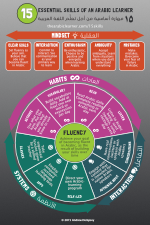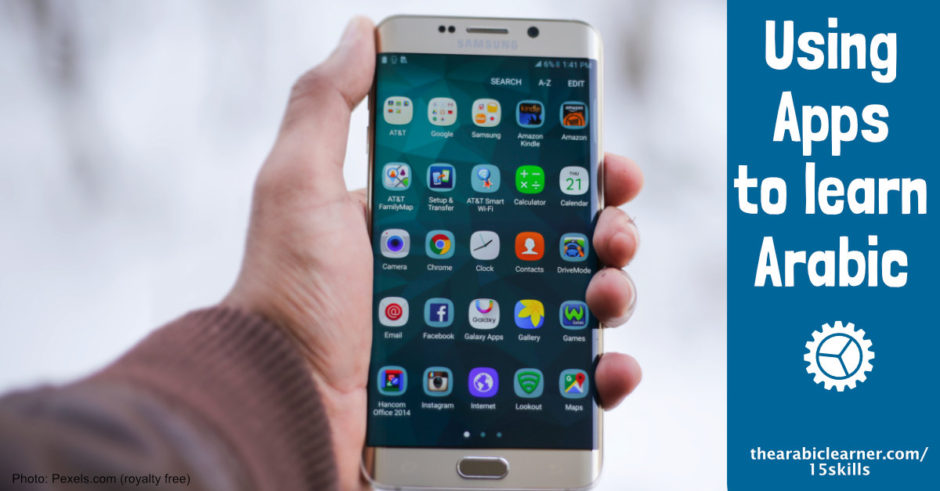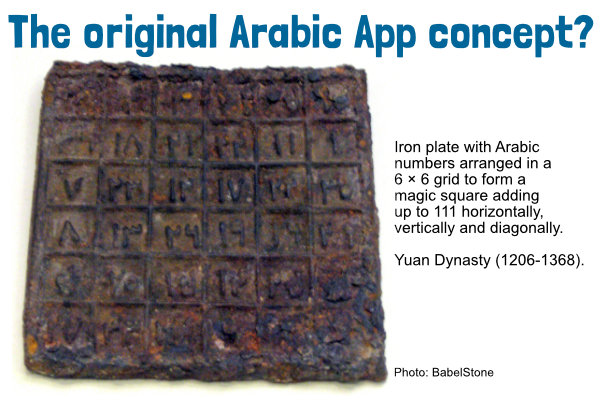 Take advantage of the increasing number of computer-assisted language learning tools that are available for Arabic learners, to work specific language skills. These apps, whether websites or software that runs on your computer or mobile device, can be used to provide the time-intensive drilling and practice that is usually not feasible in class. They can provide excellent exposure and practice in comprehension, pronunciation, and structure.
Take advantage of the increasing number of computer-assisted language learning tools that are available for Arabic learners, to work specific language skills. These apps, whether websites or software that runs on your computer or mobile device, can be used to provide the time-intensive drilling and practice that is usually not feasible in class. They can provide excellent exposure and practice in comprehension, pronunciation, and structure.
“Any technology that allows students to do more and better mechanical work on their own, outside the classroom, is something that we need to be thinking about” (Kristen Brustad)
This article is based on the 15 Essential Skills of an Arabic Learner.
Using apps to learn Arabic
There’s no question that using apps to learn Arabic is important part of an Arabic learner’s tool kit. But many language learners discover that finding useful computer-based language learning programs, let alone making good use of them, is often not very easy.
Back in the day, when I was completing my Master’s degree in teaching English, I had an opportunity to take the first course on Computer Assisted Language Learning that was offered in my university. I enjoyed the course a lot, although it wasn’t mostly because of the curriculum that we were taught. My favorite part was sitting in the back row of the computer lab for the entire semester, using web searches, hacks, and authoring programs to begin to formulate all kinds of wonderful apps that would help me teach languages, while pretending to pay close attention to the lecture.
Most of these apps failed. And apparently I was not successful in fooling my professor, who later told me that despite my thoughtful nods during class, she was aware that I was doing my own thing on my terminal there in the back row. Apparently she wasn’t threatened by this, but felt it was an important part of the learning process. Al-Hamdu li-lleh for great teachers!
However, something must have connected in my brain, because I spent the following two decades developing educational software and working as an educational technology consultant.
Based on my experience over the past 20 years, let me give a few thoughts about what software (which I will from now on call “apps”, referring to programs running on any kind of device, whether desktop or mobile, including web-based tools), can and cannot do when it comes to helping you learn Arabic.
3 things apps can do for you as you learn Arabic
a. Quickly introducing you to some aspects of the language
Apps that are well designed can quickly give you an introductory understanding of some aspects of Arabic language. Whether these aspects are explicitly taught, or implicitly demonstrated through use of exercises, a well-designed app can be a cost-efficient and time-efficient way for you to launch your Arabic learning.
Many people who wish to learn Arabic do not ever begin to actually learn it because they are unable to invest the time or money in an Arabic class. A computer-based approach can make these first steps much more attainable. For a cost that is usually a fraction of what a live course costs, and with the ability to learn at your own pace, an app-based introduction to the language can allow you to get your feet wet, without the risk of losing a significant amount of time or money if you find you are not able to fully pursue your Arabic learning goal at this time.
b. Helping you drill and repeat (and that’s a good thing)
In the early days of Computer Assisted Language Learning, an over-emphasis on repetitive exercises that required little cognitive processing led many to decry the “drill and kill” approach. It carried too many overtones of the Audiolingual method of the 1960s and 1970s, in which it was believed that languages could be learned by repetitive exposure and drill. Because of this, saying that apps can help you drill and repeat can make some language teachers uncomfortable.
But we need to be careful not to let the pendulum swing too far in the other direction. While repetition on its own is not enough to learn Arabic, it does have several important functions. It helps get vocabulary, sounds, and structures of the language into your short-term memory (a necessary, if not sufficient, step in getting it into your long-term memory). It also helps you develop the muscle memory that speaking and pronouncing Arabic requires. Producing speech is not only a mental task, it is a physical one involving complex muscular movements of the lips, jaw, tongue, and throat. Like any physical skill, repetition increases skill. Basketball players spend hours shooting baskets, because it makes a difference in their performance. The same principle applies to the kinesiology of speaking Arabic.
c. Optimize class time
A third thing that apps can help you do is to optimize your class time as you learn Arabic. Classroom language teachers always face the challenge of providing a learning environment in which adequate time is given to presenting new material and interacting with learners, alongside providing time for learners to repetitively practice their Arabic and receive feedback. Appropriate use of software-based drills that combine repetition and feedback can allow teachers and learners to optimize their classroom time to focus on activities that actually require the teacher’s direct input.
In an interview I conducted with Dr. Kristen Brustad, co-author of the al-Kitaab series of Arabic textbooks and Associate Professor of Arabic Studies in the Department of Middle Eastern Studies at the University of Texas at Austin, she pointed out the benefit of using technology to make classroom time more beneficial for students.
Generally, any technology that allows students to do more and better mechanical work on their own, outside the classroom, is something that we need to be thinking about how to put to best use. For example, auto-correct exercises, where students can be doing mechanical drills and get instant feedback. We knew this would be a good thing because of all the hours of human time it takes to correct, but I think that we didn’t even think to the level that the confidence boost that students get from immediately seeing if their answers correct can motivate them to keep going with that same drill. Rather than just feel like they’re stabbing in the dark. If they’re having trouble they can then come and say to the teacher, ‘I really had trouble with that drill last night, all my answers kept being wrong, what can I do differently?’ To me, this is where it’s at in terms of technology[1].
3 things that are difficult for apps to do
a. Provide strong context
One weakness of apps that focus on drills and exercises is that they often do not provide context. Sentences or vocabulary items that appear in isolation do not provide the kind of rich, authentic input that comes with the real-life use of language.
b. Provide interaction
Interaction that takes place in Computer Assisted language learning is very limited, relative to the kind of interaction that comes from actual conversations in Arabic, or student-teacher interaction. No matter how sophisticated the software, computer-generated interactions are different from human ones. The greatest advances in this area have been made in English language settings, and even then the interactions lack human quality. Try using Google Translate using two highly-used languages, such as English and French, and you’ll still come across parts that feel very unnatural or awkward. How much more in Arabic.
c. Provide strategic feedback
The ability of apps to provide strategic feedback to you about your learning is limited. While it is true that one strength of software-based learning is that it can give immediate technical feedback (you selected the correct answer, you spelled a word correctly, etc.), it is very difficult for apps to track with the big picture of your learning and provide you with the kind of insightful feedback that a teacher can. This includes feedback about important areas of speech such as pronunciation, inflection, or pace, as well as bigger picture feedback such as overall areas that need concentrated effort to improve.
Six different types of apps that can help you
There are strengths and weaknesses of app-based learning when it comes to Arabic. My conclusion is that while apps will not empower you to fully learn any language, when used for specific purposes they can be very useful for Arabic learners like us.
Here are six different types of language learning apps that can be helpful for learning Arabic. Some apps may overlap more than one of the areas below.
1. Learning systems
Some apps attempt to provide an entire learning system for the Arabic learner, and enable them to go from an introductory level to intermediate or advanced. The package that I am most familiar with is the Rosetta Stone Arabic series. This series teaches Modern Standard Arabic primarily through very extensive word and picture matching exercises. These exercises are presented in lessons that build on each other, and eventually take the learner into forming full sentences of some complexity.
My verdict: I think that certain types of learners can benefit from these types of programs more than others. I personally don’t find them to be the most helpful thing, in part because the price is often so high. I’m not against investing in my language learning… but I want to make sure my investment is in something that matches my learning style and personality. Sign up for the demo version first, to see if this is for you. I would suggest the same for any other comprehensive Arabic learning system software.
2. Flashcards
Flashcard apps like Memrise and Anki can be really helpful in increasing your vocabulary, and I have long been a huge believer in the value of vocabulary for rapidly growing your Arabic ability (ever since the days Abbas Al-Tonsi pushed me to levels I didn’t think I could do). These programs are often most valuable when you create and use your own decks of flashcards that are based on your own needs. Doing so, however, can be very time consuming, and most learners I have observed end up using other people’s flashcard decks, which can be a limiting factor. I also like quizlet.com, having originally used it to help my oldest daughter study for an Art History exam, and realizing its potential for just about any subject.
“Spaced repetition” is an approach to learning vocabulary from flashcards that determines how often you interact with any given word or term based on how well you have learned it so far. Spaced repetition is an excellent approach that is based on research, and I highly recommend it. The main challenge with it is that it requires a daily commitment of time, for a considerable time, if you want to enjoy the acceleration that it brings to your vocabulary acquisition. This is not a problem if you have established a daily habit of growing your vocabulary (see my previous blog post on this), but it does mean that spaced repetition will be of limited value to the casual learner.
3. Skill building
Some apps focus on specific language skills in Arabic, and allow learners to concentrate on developing that skill more intensively. An example of this type of app was the Arabic Vocab Clinic series of software. This was the software developed by my company (Kairos Information Technology) and published by the American University in Cairo Press, in 2004-2006 (including Egyptian Arabic Vocab Clinic, Modern Standard Arabic Vocab Clinic, and Modern Standard Arabic Verb Clinic). I use the word “was”, because the software has since gone out of circulation. I am currently slowly working toward releasing an upgrade, but that’s another story that you will hopefully hear about soon (interested in being informed about that when it happens?).
The software was a “clinic” that focused on vocabulary acquisition and on the skill of pronunciation. Users could browse or search for words and expressions, listen to them, view them in visual form (through audio waveforms), and record their own pronunciation, comparing the waveform with that of the native speaker. There were also extensive notes that gave insights into the context of each vocabulary item and its different uses. The app was essentially developed to scratch my own itch. I have had upgraded, personal version of it on my computer since 2011 that is not ready for public consumption, but continues to scratch my itch! So many projects, so little time…
I have not come across many other publicly available apps that work skills in similar ways. There are some available in certain university Arabic programs, but so far I haven’t come across any that are commercially available without enrolling in a course. If you know of an app that focuses on specific language skill acquisition for Arabic, please let me know!
4. Utilities
There are a number of utility apps that can be helpful for Arabic language learners. The one I probably use the most in my own reading or writing is Google Translate. I use it as a quick reference tool to either help me understand a word that I have not yet encountered (using it more or less as a dictionary), or to come up with a word that I want to write. Of course, we all know that Google Translate can help you just enough to be dangerous, and give you just enough rope to hang yourself! I think that it’s most helpful as a resource for people with some previous background in Arabic language. Use with caution.
Communication apps such as Skype, Whatsapp, or others that allow instant communication with Arabic native speakers or Arabic learners can be incredibly helpful. The main challenge in this is to find people with whom you can communicate, who are of help to you in the stage and level of ability in which you find yourself.
Other examples of utility apps include electronic dictionaries, and things as simple as Arabic keyboards on phones, tablets, or computers.
5. Online courses
One of the areas that has begun to see significant growth in the past few years is online courses. These are typically a series of online content made up of videos, audio, exercises, etc., in which a teacher will walk students step by step through a set of content. Online courses can hold significant advantages over traditional textbook-led approaches to self-directed learning, because they are highly visual and interactive. They allow students to progress at their own speed, and to review course content as often as they would like.
As a teacher, I have recently released a number of online courses in different subjects. In the Arabic learning space, my first course is the Egyptian Arabic Absolute Beginner’ Course. It is a short workshop (can be completed in 3-4 hours total) designed to take learners through their very first steps in Egyptian Arabic.
One of the biggest online learning sites that offers Arabic courses is udemy.com. You can search or browse for Arabic courses there.
Typically online courses offer advantages of time (no getting to and from lessons), economy (usually they cost less than enrolling in courses at a university or institute), pace (you can move at your own pace), and convenience. In my experience, the main challenge faced by online students is having the drive to fully complete the course. This is, in part, why I am personally experimenting with courses that are shorter, so that learners can take them in bite-sized chunks.
6. Resource collections
A final type of app worth mentioning are resource collections. Most of these take the form of websites in which you can access useful resources for learning Arabic, such as recordings of native speakers using the language. The good sites, with materials that are useful on an ongoing basis, are usually pay-for-membership sites. The one site that I often recommend that falls in this category is talkinarabic.com.
Conclusion
Apps can be very helpful for Arabic learners. However, it’s good to keep in mind that, compared to other major languages such as English, French, Spanish, etc., the number of useful apps in the Arabic language learning space is limited. I hope that this collection of thoughts and categories will help you in evaluating ways in which a specific app might or might not be helpful to you. If you have any questions, please leave a comment or send me an email!
[1] Personal interview with Dr. Kristen Brustad, 18 May 2015.




 RSS - Posts
RSS - Posts